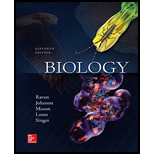
During development, cells become
a. differentiated before they become determined.
b. determined before they become differentiated.
c. determined by the loss of genetic material.
d. differentiated by the loss of genetic material.
Introduction:
When an undifferentiated cell divides, it doesn’t differentiate immediately. It decides its fate before following the decision. This decision making is termed as determination. A determined cell differentiates into the cell it was determined to be.
Answer to Problem 1U
Correct answer:
A cell always determines before differentiating into a specific cell. Therefore, option b. is correct.
Explanation of Solution
Reason for the correct statement:
A cell can’t commit to a particular differentiation as soon as it divides. It first determines its fate, then it commits to be a particular cell. Moreover, a determined cell might change its fate and differentiate into a different cell type positional signaling.
Option b. is given as “determined before they become differentiated”.
As “during development, cells become determined before they become differentiated”, it is the right answer.
Hence, option b. is correct.
Reasons for the incorrect statements:
Option a. is given as “differentiated before they become determined”.
Cells first determine then differentiate not the other way around. So, it is a wrong answer.
Option c. is given as “determined by the loss of genetic material”.
The genetic loss can’t help in the determination and development of a cell. So, it is a wrong answer.
Option d. is given as “differentiated by the loss of genetic material”.
The genetic loss can’t help in the differentiation and development of a cell. So, it is a wrong answer.
Hence, options a., c., and d. are incorrect.
A cell first determines than differentiates during the course of development.
Want to see more full solutions like this?
Chapter 19 Solutions
Biology
- Fill in the blank: _________________ is the phase of development during which cellular divisions result in smaller and smallercells.arrow_forwardThe term differentiation refers to (a) the loss of genes from cells. (b) the acquisition of new functional capabilities by cells. (c) the production of functionally specialized cells. (d) the division of genes among different types of cells.arrow_forwardWhich of the following statements is/are true? A. Spermatogenesis is an example of asymmetric cell division. B. The formation of a mature egg occurs through symmetric cell division. C. Spermatogenesis and oogenesis are both examples of asymmetric cell division. D. Spermatogenesis involves only symmetric cell division whereas oogenesis involves asymmetric cell division.arrow_forward
- Why is it easier to manipulate embryonic stem cells to differentiate into various tissues than it is to manipulate a typical adult cell? a. As cells develop, signaling pathways can cause some genes to be turned off during development. b. Adult cells have different DNA content than do embryonic stem cells. c. Emybronic stem cells pose less of a threat for organ rejection as do an individual s own adult cells. d. It is no easier to manipulate emybronic stem cells to differentiate into various tissues than it is to manipulate a typical adult cell.arrow_forwardStargardt's disease was one of these that can be treated using embryonic stem cells. Why would scientist chose to use this type of stem cell in treatment of Stargard's? A. There ae not ethical issue concerning their use B. They retain stem cell properties even after specialization C. They are able to differentiate into the required cell type D. They are already specialized for this funtionarrow_forwardWhich of the following best describes the concept of cell differentiation during the development of a multicellular organism? A. During development, all of the genes in the embryo's cells are expressed at first, but fewer and fewer are expressed as time proceeds. B. During development, different sets of genes are deleted from different cell types so that at the end of development, each cell has only the genes it needs. C. During development, different cells become specialized to have different phenotypes even though they all originated from the same cell. ..arrow_forward
- List and briefly describe the four stages that are thoughtto have led to the formation of the first cells.arrow_forwardWhich of the following is NOT an example of cell migration as a part of cell differentiation? A. Mesenchyme cells forming mesoderm during gastrulation B. Primitive streak formation in a chick embryo C. Concentration of protein complexes during cleavage D. Convergent extension to elongate the archenteron in the sea urchinarrow_forwardIf you observed fruit flies with the following developmental abnormalities, would you guess that a mutation has occurred in a segmentation gene or a homeotic gene? Explain your guess. A. Three abdominal segments were missing. B. One abdominal segment had legs. C. A fly with the correct number of segments had two additional thoracic segments and two fewer abdominal segments.arrow_forward
- What is differentiation? A. When a cell switches from its original purpose B. The process of multiplying the cells in the body C. The process by which cells become specialized in their form to aid in their function D. How cells grow once their place in the body has been decidedarrow_forwardThe process forming the neural tube and plate via the intercalation of cells along the medial-lateral axis and extension along the anterior-posterior axis occurs is called? a. neurulation b. embryogenesis c. convergent extension d. morphogenesisarrow_forwardThe term cellular differentiation refers to (a) the loss of genes from cells. (b) the acquisition of new functional capabilities by cells. (c) the production of functionally specialized cells. (d) the division of genes among different types of cells.arrow_forward
 Biology (MindTap Course List)BiologyISBN:9781337392938Author:Eldra Solomon, Charles Martin, Diana W. Martin, Linda R. BergPublisher:Cengage Learning
Biology (MindTap Course List)BiologyISBN:9781337392938Author:Eldra Solomon, Charles Martin, Diana W. Martin, Linda R. BergPublisher:Cengage Learning
